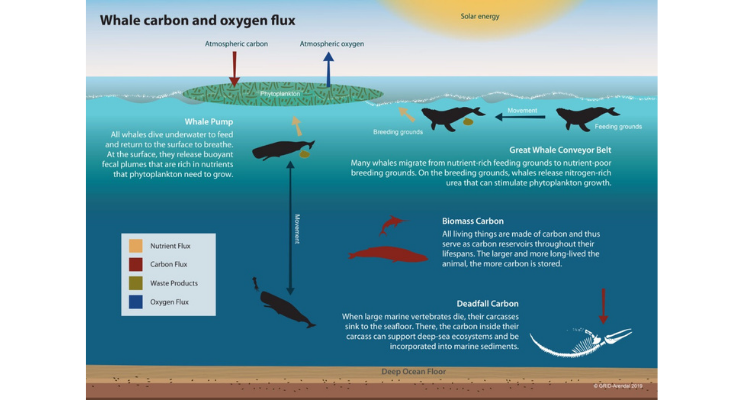Ever wondered how these majestic beings contribute to the planet, just by being their majestic selves? Ever thought of the consequences their decline would have on the environment?
Whales form symbiotic relationships with a lot of marine organisms and circulate nutrients and gases throughout water bodies, mainly through their fecal plumes, urine, sloughed skin, and placental materials.
One of their major contributions is the absorption of carbon dioxide. A whale can absorb up to 33 tons of carbon dioxide throughout its life and once it dies, it takes that carbon out of the atmosphere for many many centuries to come when its carcass sinks to the ocean floor. In contrast, a tree absorbs only about 48 pounds of carbon dioxide a per year.
The mechanism of this circulation also begins with a whales symbiotic relationship with phytoplankton. Phytoplankton are microscopic marine organisms that sit at the bottom of the food chain and begin the food cycle. They are food for other plankton and small fish, as well as larger animals such as whales. Phytoplankton get their energy from carbon dioxide through photosynthesis (like plants) and so are very important in carbon cycling.
In a study of blue whales in Antarctica, it was determined that the iron concentration in the feces of whales is 10 million times more than that of Antarctic seawater. THis in turn triggers the blooming of phytoplankton, which in turn increases the fishery yield. It has been found that blue whales transport approximately 88 tonnes of per year and may have transported approximately 24,000 tonnes of nitrogen through the conveyor belt, prior to their commercialization.
The deep diving and surfacing behavior of sperm whales and some baleen whales transports nutrients in their fecal plumes from deeper water to the surface and, for gray and humpback whales, by carrying sediment from the seafloor and redistributing it in the water column, to the benefit of sea birds and other marine species.
This mixing of nutrients is referred to as biomixing and it contributes to a third of the mixing ocean mixing and is comparable to the biomixing that occurs due to tides or winds.
As noted by Dr. Joe Roman and Dr. James McCarthy, “Cetaceans feeding deep in the water column effectively create an upward pump, enhancing nutrient availability for primary production in locations where whales gather to feed.” This vertical transport of nutrients is referred to as the “whale pump” and was first postulated in 1983.
Due to the significant loss of whales to commercial whaling, current populations of large baleen whales store 9.1 million tonnes less carbon than if their numbers were at pre-exploitation levels. If these whale stocks were restored, they would remove 160,000 tonnes of carbon each year through whale falls, which is roughly equivalent to 110,000 hectares of forest (or an area the size of Rocky Mountain National Park).



